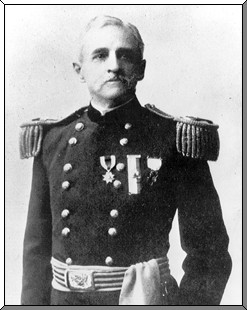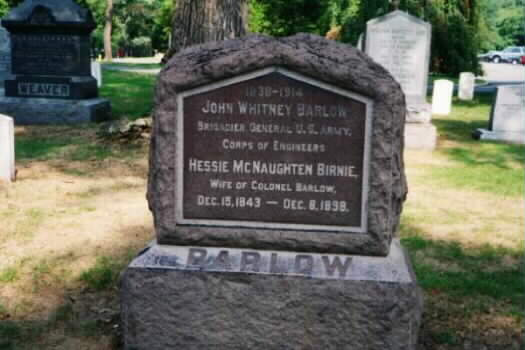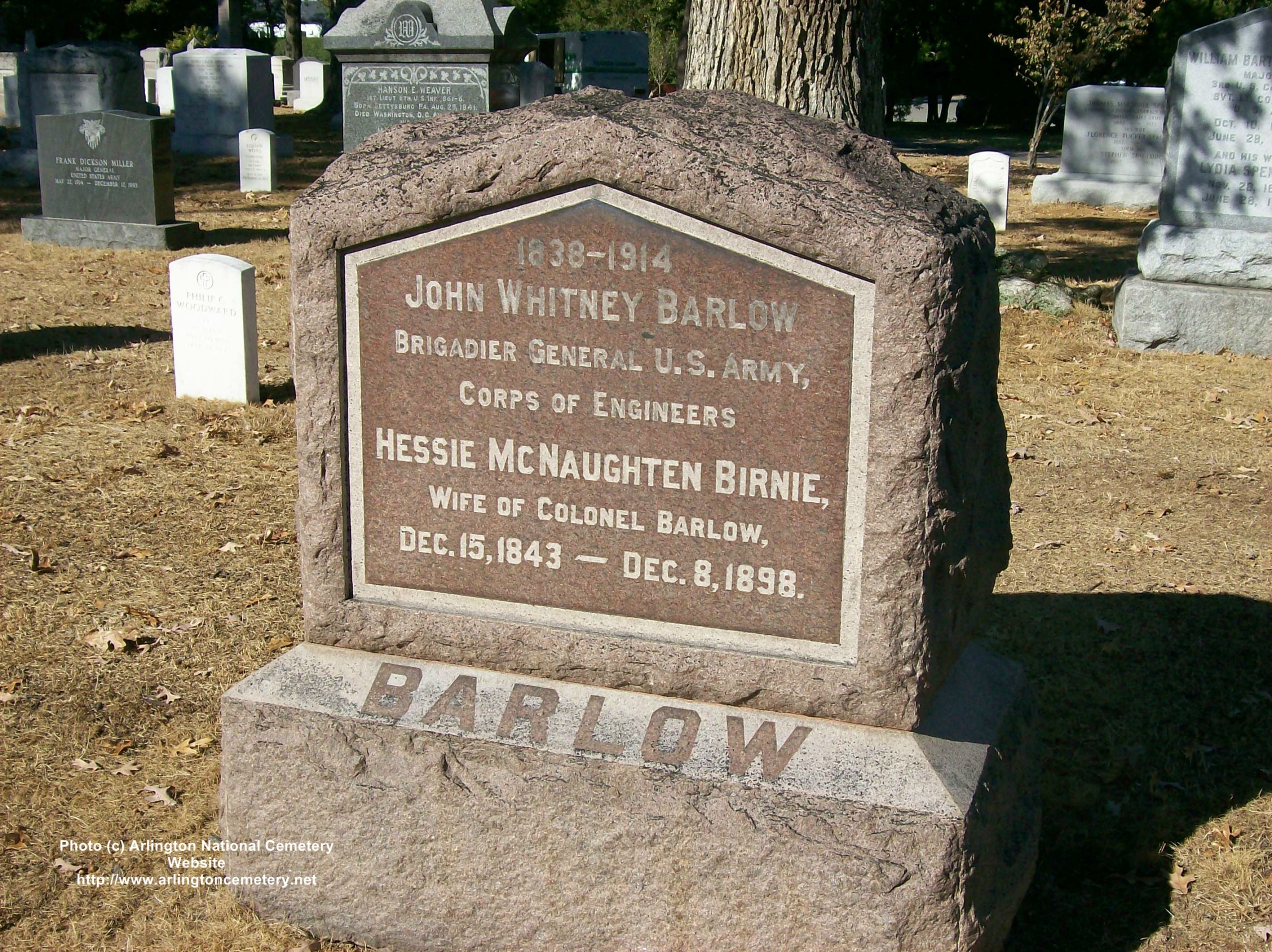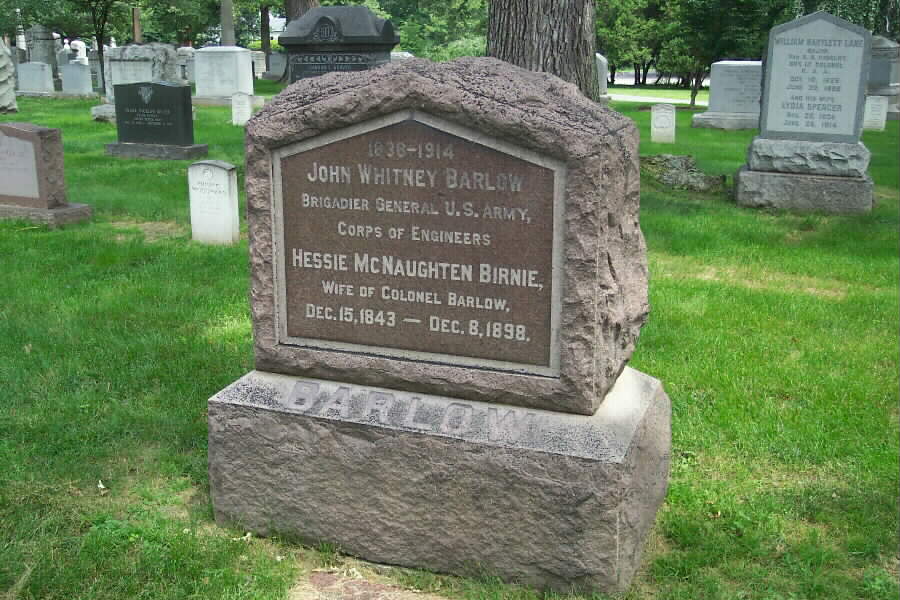Born in Wyoming County, New York. He was appointed to the United States Military Academy from Wisconsin. He never rose above cadet rank of Sergeant. His marks were in the top third of his class, and he graduated 14th. Remembered as devout Christian and loyal Churchman.
Modesty, courtesy, bravery, and wisdom were his attributes. Classmates cherished him as “an entirely loveable person.” He graduated into the 2nd Artillery and fought with this Regular Army outfit at Bull Run and through Peninsula Campaign. For a time his battery was attached to the Cavalry.
During the battle of Williamsburg men of his section were swept back by a rush of Confederate Cavalry. Lieuteannt Barlow, with a single soldier to help him, threw one of the guns into the battery, loaded and fired it in face of enemy, and fought them off. At Hanover Court House he took one gun to the picket line, and with it repelled a Confederate regiment with canister shot. He was commended by General George McClellan for this action, and was brevetted Captain. At the end of July 1862, he was transferred to the Topographical Engineers, and in March 1863 to the Corps of Engineers.
He served as Assistant Professer of mathematics at West Point for 6 months, also teaching geography, history and ethics (they were short-handed at USMA in those days).
In June 1863, he returned to Army of the Potomac and fought through Gettysburg. From that point on he built a number of bridges, including one over the Rappahannock at Kelly’s Ford, November 1863. In February 1864 he returned to the mathematics dept. In June he went to Georgia and served as chief engineer of Sherman’s XVII Army Corps. On sick leave from August to November and then back in charge of the defenses of Nashville. He was still in the West when war ended.
He stayed in the engineers and supervised construction of forts in Florida, New York and Connecticut. He worked on harbors on the Great Lakes and along the Hudson River. He was involved in opening canal at Mussell Shoals. In the 1870’s he conducted a geological study, under Dr. F. V. Hayden, which became first government exploration of the Yellowstone Region. His work resulted in the formation of Yellowstone National Park, and its publication gave him a lasting place in the country’s history. A great part of his valuable collection of data and photographs was destroyed in the Chicago fire, as was his first copy of Cullum’s Register. He Promptly ordered three copies of the register, and completed his admirable report on the exploration from memory. In 1872 he accompanied a surveying expedition for the Northern Pacific Railroad. The party was attacked by 1,000 Indians under Sitting Bull. The attack repulsed by an escort of 400 men. His report of the expedition was highly praised by General William T. Sherman.
In the 1890’s, he commanded a joint commission of engineers from both countries who worked together surveying and placing perm markers between the US and the Mexican Republic from El Paso to the Pacific Ocean. On May 2, 1901 became Brigadier General and chief of the corps of engineers, retiring from active duty the next day.
He was one of the classmates that Ames had described as being “seized by a perfect mania for getting married.” He married Hessie McNaughton Birnie in the Church of Epiphany, Washington, DC, on the day after Christmas, 1861. They moved to a honeymoon home at 55 Pennsylvania Avenue. Mrs Barlow died many years later, and the widower married Alice Stanton Turner on September 17, 1902. After he retired, they made their home in New London, Connecticut.
In 1912-1913 he was President of the Association of West PointGraduates. In the winter of 1913-14, the couple took trip to the Holy Land. There taken ill. Died in Jerusalem, February 27, 1914, at the age of 76. His funeral was held 2 months later at Fort Myer, Virginia, with burial in Arlington National Cemetery.
Courtesy of the United States Army
Chief of Engineers (May 2, 1901-May 3, 1901)
John Barlow was born in New York City on June 26, 1838, and graduated from the Military Academy in May 1861. He was first commissioned in the Artillery Corps, but transferred to the Topographical Engineers in July 1862. He served with the Battalion of Engineers at Gettysburg and as engineer of an army corps in the siege of Atlanta. He supervised the defenses of Nashville and was brevetted lieutenant colonel for his gallant service there in December 1864. From 1870 until 1874 he was General Sheridan’s Chief Engineer in the Military Division of the Missouri. During this period he made scientific explorations of the headwaters of the Missouri and Yellowstone. His detailed reports became guides for settlers. Barlow improved the harbors and defenses of Long Island Sound from 1875 to 1883, executed harbor improvements in northern Wisconsin and Michigan, and worked on the construction of a canal around Muscle Shoals on the Tennessee River. He was the senior American member of the international commission that re-marked the disputed boundary with Mexico in 1892-96. He was subsequently Northwest Division Engineer for four years. On May 2, 1901, he was commissioned brigadier general and appointed Chief of Engineers. The next day, May 3, 1901, he retired from the Army after 40 years of service. He died February 27, 1914, in Jerusalem, Palestine, at the age of 75.
March 03, 1914
GEN. JOHN W. BARLOW DEAD
Retired Chief of Engineers Was on a Tour of the Holy Land.
General John W. Barlow, U.S. A., (retired.) of New London Connecticut, died on Sunday in Jerusalem. Accompanied by his wife, he was making a tour of the Holy Land.
General Barlow sailed for Europe February 2.
General John Whitney Barlow was born in 1838 at Perry, New York, and was graduated in 1861 from West Point. He was appointed a Second Lieutenant of Artillery in May, 1861, and later transferred to the topographical engineers. He was made Captain in July, 1863, Major in 1869, Lieutenant Colonel in 1881, Colonel in 1895, and Brigadier General and Chief of Engineers in 1901. He was retired in 1901 at his own request after forty years of service. He took part in many of the great battles of the war, and was brevetted three times for meritorious services. He was with the Army of the Potomac and with Gen. Sherman on the march to the sea as a builder of roads, bridges, and fortifications.
Ater the war General Barlow was an engineer in charge of harbor construction on Lake Champlain, and later at Chicago, New London, Connecticut;Milwaukee, and other cities. He made original explorations of the headwaters of the Yellowstone and Mississippi Rivers.
General Barlow was a member of the Association of Graduates of West Point, of the Military Service Institution of the United States, of the Societies of the Army of the Potomac, of the Cumberland and of the Tennessee, and a companion of the Loyal Legion. In this city he belonged to the New York Athletic Club, the National Arts Club, and the Army and Navy Club.
BARLOW, JOHN W
- United States Army
- DATE OF DEATH: 02/27/1914
- BURIED AT: SECTION 1 SITE 191WS
ARLINGTON NATIONAL CEMETERY
BARLOW, HESSIE M W/O J W
- DATE OF DEATH: 12/08/1898
- BURIED AT: SECTION E.SDE SITE 191
ARLINGTON NATIONAL CEMETERY - WIFE OF JW BARLOW, COL ENG CORPS



Michael Robert Patterson was born in Arlington and is the son of a former officer of the US Army. So it was no wonder that sooner or later his interests drew him to American history and especially to American military history. Many of his articles can be found on renowned portals like the New York Times, Washingtonpost or Wikipedia.
Reviewed by: Michael Howard

